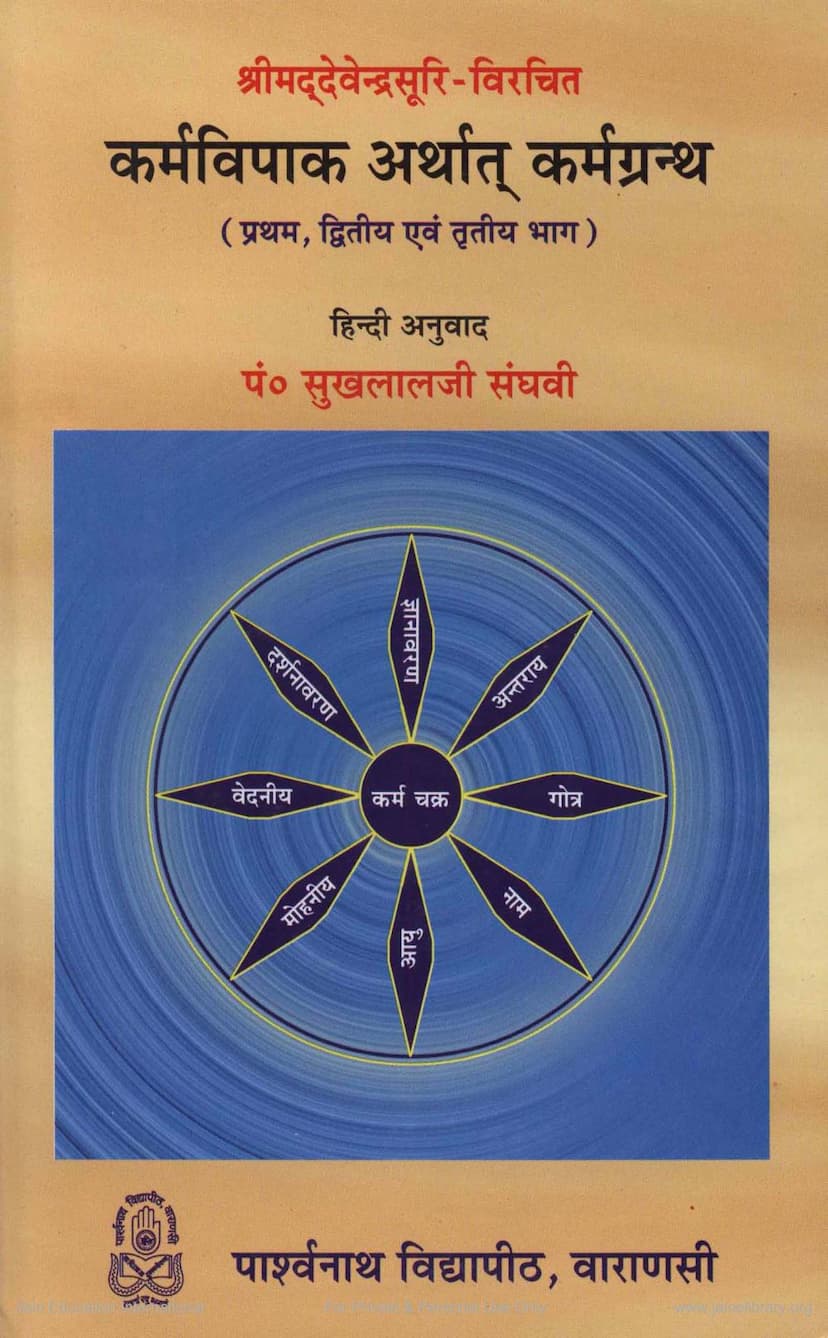Karmagrantha Part 1 2 3 Karmavipaka Karmastav Bandhswamitva
Added to library: September 2, 2025

Summary
This is a summary of the Jain text "Karmagrantha Part 1, 2, 3: Karmavipaka, Karmastav, Bandhasvamitva" by Devendrasuri, translated and annotated by Sukhlal Sanghavi, and published by Parshwanath Vidyapith, Varanasi.
The book is a comprehensive exploration of the Jain theory of karma, which is considered the heart of Jain philosophy. The text emphasizes that karma itself is the provider of its fruits, and Jainism rejects the concept of an external deity like God as a controller of karma or creator of the universe. Instead, it posits that the soul (Atma) is the divine entity, and liberation (Ishvaratva) is achieved through the soul's own efforts to shed the veils of karma.
The core concepts discussed revolve around the Karmavipaka (the fruition of karma) and the Karmastav (praise or glorification of karma). The text details the eight types of karmas, their classifications into original (mūla) and secondary (uttara) categories, and their specific characteristics and effects.
Key Aspects Covered:
- Nature of Karma: The text delves into the intricate workings of karma, explaining how it binds the soul and influences its experiences of happiness and suffering, birth and death, and various life circumstances.
- Eight Karmas: The book systematically describes the eight primary karmas and their numerous sub-categories:
- Jñānāvaraṇa (Knowledge-obscuring karma)
- Darśanāvaraṇa (Perception-obscuring karma)
- Vedanīya (Feeling-producing karma)
- Mohanīya (Delusion-producing karma)
- Āyu (Age-determining karma)
- Nāma (Body-determining karma)
- Gotra (Status-determining karma)
- Antarāya (Obstruction-causing karma)
- Classification of Karmas: The text elaborates on the multitude of secondary karmas derived from these eight original ones, totaling 158 (or other counts depending on classification). It meticulously explains the nature, effects, and classification of these karmas.
- Bindha (Bondage): The text describes the four aspects of karma bondage:
- Prakṛti-bandha (Bondage of nature/type)
- Sthiti-bandha (Bondage of duration)
- Rasa-bandha (Bondage of intensity/flavor)
- Pradeśa-bandha (Bondage of quantity/particles)
- Vipāka (Fruition): A significant portion of the text focuses on the "Vipāka," the process by which karmas mature and produce their results, influencing the soul's present and future experiences.
- Knowledge and Perception: The text describes the five types of knowledge (mati, śruta, avadhi, manahparyaya, kevala) and the four types of perception (cakṣu, acakṣu, avadhi, kevala), explaining how karmas obscure these essential qualities of the soul.
- The Cycle of Karma: The book explains how actions (karma) lead to bondage, which in turn influences future births and experiences, creating a continuous cycle of rebirth and suffering until liberation is achieved.
- Path to Liberation: The text indirectly points towards the path of liberation through right faith (Samyagdarśana), right knowledge (Samyagjñāna), and right conduct (Samyagcāritra), which are the means to break free from karmic bondage.
- Distinction between Jain and Other Philosophies: The "Prakaraṇam" (Introduction) highlights the uniqueness of Jain karma theory in its rejection of external divine intervention and its emphasis on the soul's autonomy in its karmic journey. It also addresses common criticisms leveled against karmavāda.
- Structure and Content: The book is divided into three parts, each systematically detailing different aspects of karma. The second part focuses on the "Karma-stotra" (Karmastav), praising the Tirthankaras and their liberation from karma, while also detailing the application of karma theory across different "Guṇasthānas" (stages of spiritual development). The third part, "Bandhasvamitva," delves into the specific karmic bondage related to various "Mārgaṇās" (life conditions or paths, such as rebirth, senses, faculties, etc.) and their correlation with guṇasthānas.
- Appendices: The book includes valuable appendices, such as a glossary of Prakrit terms, lists of Śvetāmbara and Digambara texts on karma, and comparative tables, making it a comprehensive resource for the study of Jain karma theory.
In essence, this work is a foundational text for understanding the complex and central doctrine of karma in Jainism, presented in a clear and systematic manner with scholarly annotations.